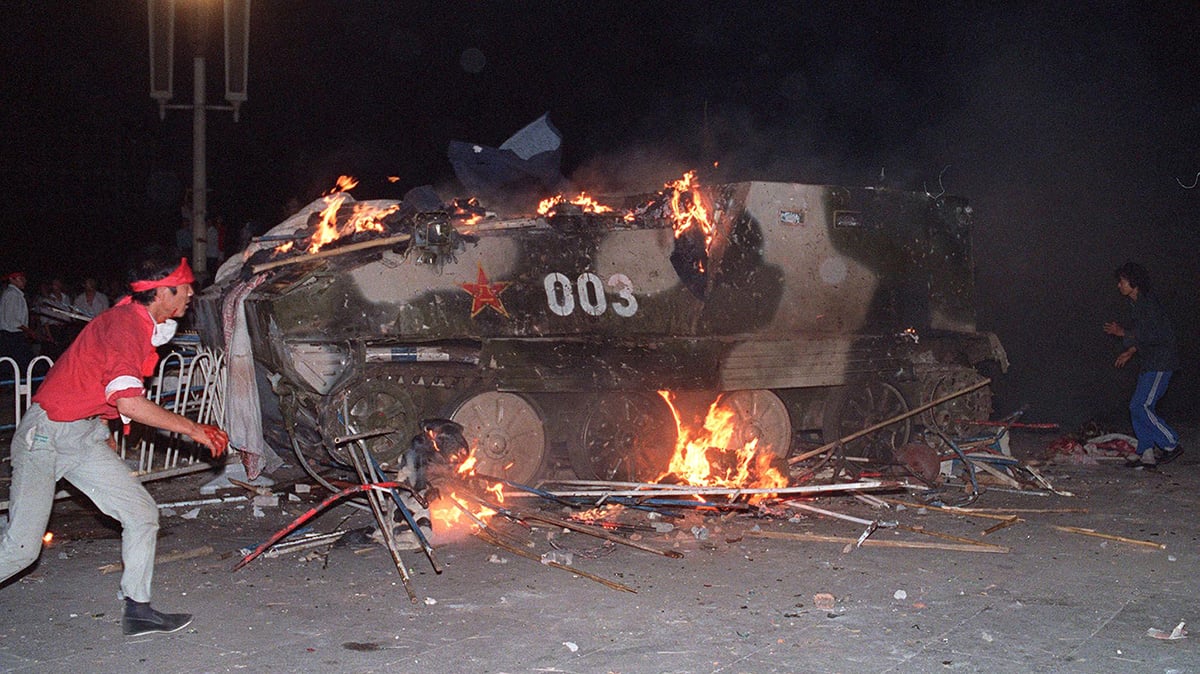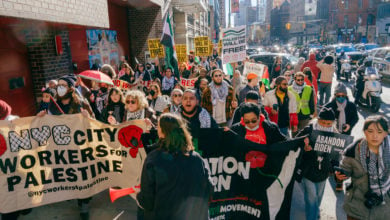On Dec. 22, well over 100 thousand people in Nepal’s capital, Katmandu, attended the closing rally of a three-day general strike called by the Unified Communist Party of Nepal (Maoist). The strike shut down virtually all business, schools and public transportation.
 General strikers in Katmandu shut down roads around government buildings |
This event was the capstone of the latest round of mass protests called by the communists in their campaign against the attempted seizure of the government in May by the allied forces of the Nepal Army and the country’s elite.
In May, the UCPN-M resigned from the government. It led the government as a result of a landside electoral victory. The walkout came in response to the Nepal Army’s disavowal of peace agreements and illegal defiance of the coalition government led by the UCPN-M.
Since May, the UCPN-M has blockaded and shut down parliament in response to attempts by the Communist Party of Nepal (Unified Marxist-Leninist) and the Nepali Congress to run the government. Both parties have sided with the Nepal Army in the current struggle. The Nepal Army is notoriously reactionary and bloody. The NA is loyal to the country’s tiny elite and guilty of widespread brutality and torture.
The struggle of the Nepalese people is long and heroic. From 1768 until May 28, 2008, Nepal was a Hindu Kingdom ruled by the Shah and Rana dynasties. The current period of upheaval can be traced back to 1996, when revolutionary forces led by the Communist Party of Nepal (Maoist) established the People’s Liberation Army and launched a guerilla war against the government.
The People’s War gradually gained momentum and enjoyed a broad base of support in rural areas. By 2006, discontent had reached a boiling point, and what became known as People’s Movement 2 (the first People’s Movement occurred in 1990) was launched. The monarchy was overthrown and after several postponements, an election for the Constituent Assembly, the legislative body tasked with drafting a republican constitution, was held on April 10, 2008.
The Maoists won by far the greatest number of seats (over 38 percent) and formed a coalition with the Communist Party of Nepal (Unified Marxist-Leninist), a social democratic party, and the Madhesi People’s Rights Forum.
The Maoist leader Pushpa Kamal Dahal, better known by his nom de guerre, Prachanda, became Prime Minister. A few months into his tenure Prachanda sought to have the insubordinate leader of the traditionally royalist Nepal Army, Rookmangud Katawal, replaced for violating the terms of the U.N. brokered peace treaty between the PLA and the Nepal Army. In a gross violation of the interim constitution, President Ram Baran Yadav, from the capitalist Nepali Congress Party, instructed Katawal to remain in his position.
In response to this act of military subversion of the elected government, UCPN-M (“unified” was added to the name after a merger in January) withdrew from the government. A new administration led by the CPN (UML) with the support of the NCP was formed amidst a series of actions called by the Maoists to re-establish civilian supremacy.
After a long period of political deadlock the UCPN-M decided to initiate an umbrella organization of revolutionary, nationalist, and republican forces called the United National People’s Movement to launch a two week-long second phase of protests.
Beginning Nov. 2, municipal and regional government offices were shut down on designated days by communist-led forces throughout the country. A general strike was then called in Katmandu, and the campaign climaxed with a two-day encirclement of Singha Durbar, the complex that houses all main state institutions.
After the government ignored the Nov. 20 deadline to rectify Yadav’s move, the UNPM announced third phase protests, the centerpiece of which would be a general strike from Dec. 20 through 22.
Sixteen days before the beginning of the strike, landless farmers organized by the Maoists that had been occupying parts of the Dudejhari jungle in the Kailali district of Nepal were violently evicted. When the dust cleared, at least four squatters had been killed and hundreds of others wounded by security forces. A highly successful nationwide strike was called in outraged response two days later.
Despite threats and maneuvering by the U.S. and Indian governments, the general strike began as scheduled, bringing the country to a complete commercial standstill. A significant amount of violence broke out as police attempted to repress the demonstrations and protesters defended themselves. Scores were arrested or injured, and the deputy superintendent of police, Dilip Chaudhary, was nearly killed.
Their very existence threatened, elements of the Nepalese elite have grown more militant. Sukhdev Shah, ex-ambassador to the United States and an American citizen, recently wrote, without a hint of sarcasm, “Another big uncertainty is if Nepal has the good fortune of some strongmen rising to the occasion—the likes of Korea’s Park Chung-He, Chile’s Pinochet, Indonesia’s Suharto—to take up the challenge of suppressing dissent. …” (myrepublica.com, Dec. 20). All three of the leaders mentioned were brutal dictators responsible for the murder of hundreds of thousands of people.
The struggle for the future of Nepal continues. The communists have led the struggle to defend the interests of the Nepalese masses in the fight against the combined forces of the Nepalese elite, India and U.S. imperialism. The unfolding revolutionary struggle in Nepal requires our attention and solidarity.





